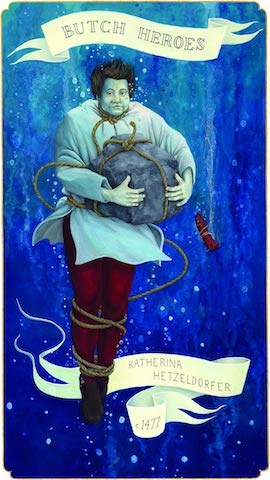In 1477 Katherina Hetzeldorfer was roped to a boulder and drowned in the Rhine. Her crime was to have lived with a woman in a relationship ‘like that of husband and wife’. Reminiscent in style and format of a prayer card, Ria Brodell’s gouache-on-paper portrait renders Hetzeldorfer, stout with short hair, in red trousers and white tunic, stoically resigned to her fate as she hugs the rock that will drag her to a watery grave. In a final indignity, it would seem that Hetzeldorfer’s executioners have also thrown into the river the ‘instrument’ – a stick wrapped in red leather – that the accused was supposed to have used to penetrate her partner.
Hetzeldorfer’s biography and the circumstances of her death are detailed in a short written account running alongside the artwork; a template repeated over 28 further spreads in this slim volume. Each introduces a ‘butch hero’ – a historical figure with whom most readers are unlikely to be familiar – spanning cultures and centuries, united only in the fluidity of their gender or sexuality. There are questions to be asked as to the wisdom of using Christian symbolism to talk of subjects that lived outside such a culture (Asian and Indigenous subjects among them), and a sense of presentism in Brodell’s reliance on the language of US gender theory (the projection of guessed pronouns is problematic). Yet the fact that Hetzeldofer’s fate is not the norm in the stories told here reveals something about the purpose of Brodell’s project.
There are plenty of sad tales, each assiduously researched through both primary and secondary sources: Sakuma Hideka and Chiyoka were a Japanese couple who attempted suicide after their polyamorous relationship with a third woman came to light, and Catharina Linck aka Anastasius was beheaded after his mother-in-law shopped him for having female body parts. However, what is striking is how many of those profiled enjoyed happy lives – some keeping their birth sex secret, others living openly as lesbian or trans.
Captain Wright of Kennington in South London, a stout man who liked pubs and bred rabbits, led, by all accounts, a happy life; his female birth gender was discovered only on death. Likewise a relative of Naa Jian, who lived in a rural community in early-twentieth-century Thailand, described the agricultural labourer as ‘like a man’, who did ‘men’s work’ and had a girlfriend because that was ‘just the way she was’. Woman Chief was a fierce warrior with the Crow nation in the nineteenth century who kept a couple of wives; Pope Urban VIII gave his blessing for Catalina ‘Antonio’ de Erauso to dress in men’s clothing in recognition of Antonio’s service in the Spanish army’s conquests of the New World. Gender fluidity, it would seem then, is not the radical battleground that both contemporary social conservatives and today’s high-on-their-own-wokeness pundits want it to be, but as Brodell demonstrates, age-old and culturally universal.
From the January & February 2019 issue of ArtReview
